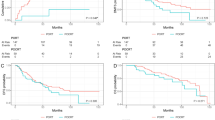Abstract
Background
Patients with peritoneal mucinous carcinomatosis (PMCA) of appendiceal origin and extensive disease are commonly advised against CRS/HIPEC. We hypothesize that CRS/HIPEC is a beneficial treatment for this group.
Methods
Retrospective analysis of 134 patients with appendiceal cancer treated with CRS/HIPEC was performed from a prospective database. Extent of disease, measured by peritoneal cancer index (PCI), was related to completeness of cytoreduction (CC), lymph node (LN) status, and prior surgery score (PSS). Overall survival (OS) was estimated by Kaplan-Meier curves. Test differences were calculated using log-rank test.
Results
A total of 77 patients (57%) had PMCA. Mean follow-up was 22 months with a median of 18 months. OS was 88%, 56%, and 40% for 1, 3, and 5 years, respectively. 68% had PCI ≥ 20. LN metastasis was found in 44% of patients in PCI ≥ 20 and PCI < 20 groups. 73% and 60% of patients had PSS of 2 or 3 in PCI ≥ 20 and PCI < 20 groups, respectively (P = .196). Complete cytoreduction was achieved in 65% of PCI ≥ 20 group and 96% of PCI < 20 group (P = .004). With complete cytoreduction, the 5-year OS was 45% in PCI ≥ 20 group and 66% in PCI < 20 group (P = .139). 18 of 19 patients with incomplete cytoreduction had PCI ≥ 20, with 3- and 5-year OS of 27% and 0%. Hazard ratios (by Cox regression) were 2.8 (95% confidence interval [95% CI] 0.8–10.2) and 3.6 (95% CI 1.5–8.8) for PCI < 20 and complete cytoreduction, respectively.
Conclusions
Meaningful long-term survival could be achieved in patients with PMCA even with extensive peritoneal disease. PCI ≥ 20 should not be used as an exclusion criterion when selecting these patients for CRS/HIPEC, and every effort should be made to achieve complete cytoreduction.



Similar content being viewed by others
References
Chua TC, Yan TD, Smigielski ME, Zhu KJ, Ng KM, Zhao J, et al. Long-term survival in patients with pseudomyxoma peritonei treated with cytoreductive surgery and perioperative intraperitoneal chemotherapy: 10 years of experience from a single institution. Ann Surg Oncol. 2009;16:1903–11.
Elias D, Honore C, Ciuchendea R, Billard V, Raynard B, Lo Dico R, et al. Peritoneal pseudomyxoma: results of a systematic policy of complete cytoreductive surgery and hyperthermic intraperitoneal chemotherapy. Br J Surg. 2008;95:1164–71.
Levine EA, Stewart JH, Russell GB, Geisinger KR, Loggie BL, Shen P. Cytoreductive surgery and intraperitoneal hyperthermic chemotherapy for peritoneal surface malignancy: experience with 501 procedures. J Am Coll Surg. 2007;204:943–53.
Omohwo C, Nieroda CA, Studeman KD, Thieme H, Kostuik P, Ross AS, et al. Complete cytoreduction offers longterm survival in patients with peritoneal carcinomatosis from appendiceal tumors of unfavorable histology. J Am Coll Surg. 2009;209:308–12.
Sugarbaker PH. New standard of care for appendiceal epithelial neoplasms and pseudomyxoma peritonei syndrome? Lancet Oncol. 2006;7:69–76.
Baratti D, Kusamura S, Nonaka D, Langer M, Andreola S, Favaro M, et al. Pseudomyxoma peritonei: clinical pathological and biological prognostic factors in patients treated with cytoreductive surgery and hyperthermic intraperitoneal chemotherapy (HIPEC). Ann Surg Oncol. 2008;15:526–34.
Ronnett BM, Zahn CM, Kurman RJ, Kass ME, Sugarbaker PH, Shmookler BM. Disseminated peritoneal adenomucinosis and peritoneal mucinous carcinomatosis. A clinicopathologic analysis of 109 cases with emphasis on distinguishing pathologic features, site of origin, prognosis, and relationship to “pseudomyxoma peritonei”. Am J Surg Pathol. 1995;19:1390–408.
Sugarbaker PH. Epithelial appendiceal neoplasms. Cancer J. 2009;15:225–35.
Ronnett BM, Yan H, Kurman RJ, Shmookler BM, Wu L, Sugarbaker PH. Patients with pseudomyxoma peritonei associated with disseminated peritoneal adenomucinosis have a significantly more favorable prognosis than patients with peritoneal mucinous carcinomatosis. Cancer. 2001;92:85–91.
Jacquet P, Sugarbaker PH. Clinical research methodologies in diagnosis and staging of patients with peritoneal carcinomatosis. Cancer Treat Res. 1996;82:359–74.
Esquivel J, Elias D, Baratti D, Kusamura S, Deraco M. Consensus statement on the loco regional treatment of colorectal cancer with peritoneal dissemination. J Surg Oncol. 2008;98:263–7.
Stewart JH, Shen P, Russell GB, Bradley RF, Hundley JC, Loggie BL, et al. Appendiceal neoplasms with peritoneal dissemination: outcomes after cytoreductive surgery and intraperitoneal hyperthermic chemotherapy. Ann Surg Oncol. 2006;13:624–34.
Elias D, Gilly F, Quenet F, Bereder JM, Sidéris L, Mansvelt B, et al. Pseudomyxoma peritonei: a French multicentric study of 301 patients treated with cytoreductive surgery and intraperitoneal chemotherapy. Eur J Surg Oncol. 2010;36:456–62.
Shapiro JF, Chase JL, Wolff RA, Lambert LA, Mansfield PF, Overman MJ, et al. Modern systemic chemotherapy in surgically unresectable neoplasms of appendiceal origin: a single-institution experience. Cancer. 2010;116:316–22.
Gough DB, Donohue JH, Schutt AJ, Gonchoroff N, Goellner JR, Wilson TO, et al. Pseudomyxoma peritonei. Long-term patient survival with an aggressive regional approach. Ann Surg. 1994;219:112–9.
Miner TJ, Shia J, Jaques DP, Klimstra DS, Brennan MF, Coit DG. Long-term survival following treatment of pseudomyxoma peritonei: an analysis of surgical therapy. Ann Surg. 2005;241:300–8.
Verwaal VJ, van Ruth S, de Bree E, van Sloothen GW, van Tinteren H, Boot H, et al. Randomized trial of cytoreduction and hyperthermic intraperitoneal chemotherapy versus systemic chemotherapy and palliative surgery in patients with peritoneal carcinomatosis of colorectal cancer. J Clin Oncol. 2003;21:3737–43.
Verwaal VJ, Bruin S, Boot H, van SG, van TH. 8-year follow-up of randomized trial: cytoreduction and hyperthermic intraperitoneal chemotherapy versus systemic chemotherapy in patients with peritoneal carcinomatosis of colorectal cancer. Ann Surg Oncol. 2008;15:2426–32.
Misdraji J, Yantiss RK, Graeme-Cook FM, Balis UJ, Young RH. Appendiceal mucinous neoplasms: a clinicopathologic analysis of 107 cases. Am J Surg Pathol. 2003;27:1089–103.
Bradley RF, Stewart JH, Russell GB, Levine EA, Geisinger KR. Pseudomyxoma peritonei of appendiceal origin: a clinicopathologic analysis of 101 patients uniformly treated at a single institution, with literature review. Am J Surg Pathol. 2006;30:551–9.
Author information
Authors and Affiliations
Corresponding author
Rights and permissions
About this article
Cite this article
El Halabi, H., Gushchin, V., Francis, J. et al. The Role of Cytoreductive Surgery and Heated Intraperitoneal Chemotherapy (CRS/HIPEC) in Patients with High-Grade Appendiceal Carcinoma and Extensive Peritoneal Carcinomatosis. Ann Surg Oncol 19, 110–114 (2012). https://doi.org/10.1245/s10434-011-1840-y
Received:
Published:
Issue Date:
DOI: https://doi.org/10.1245/s10434-011-1840-y




